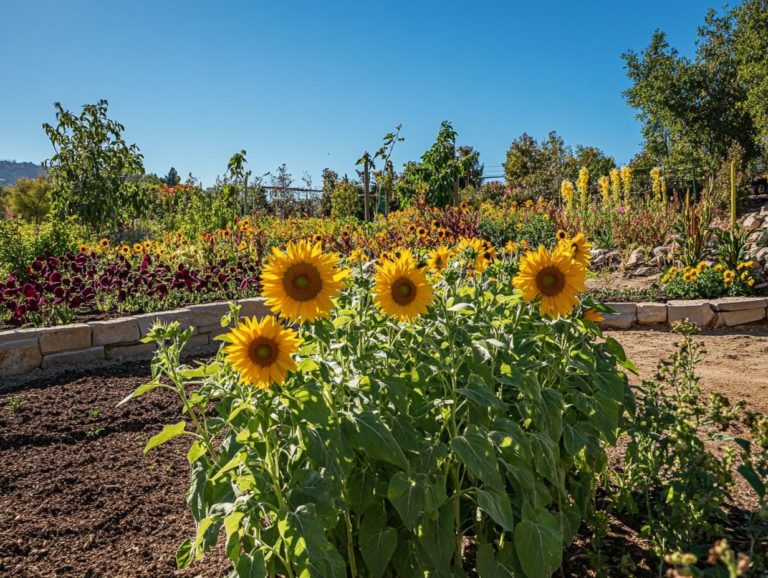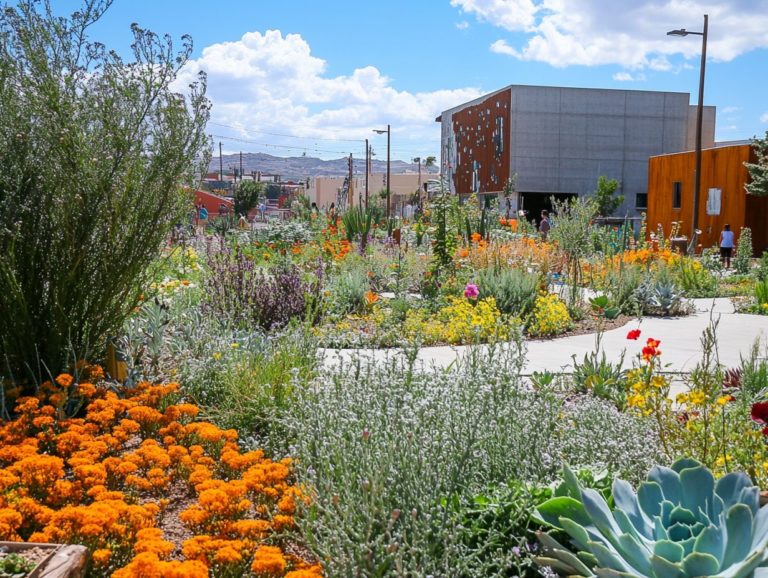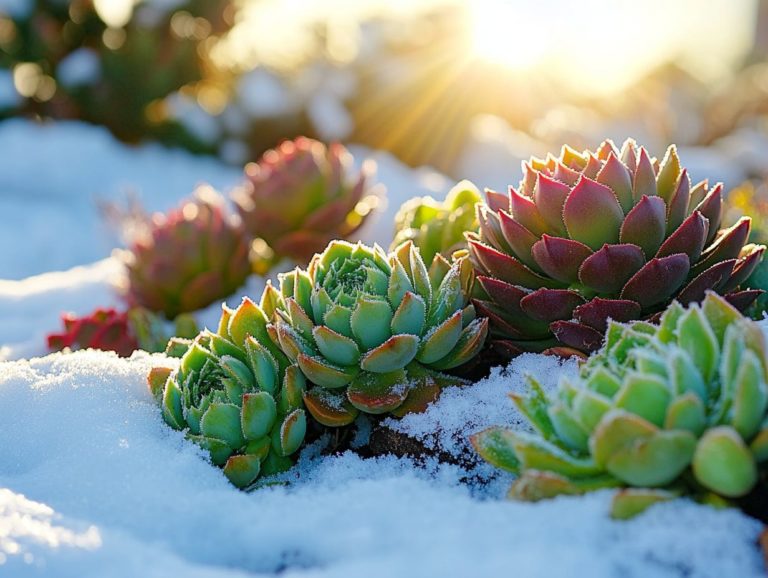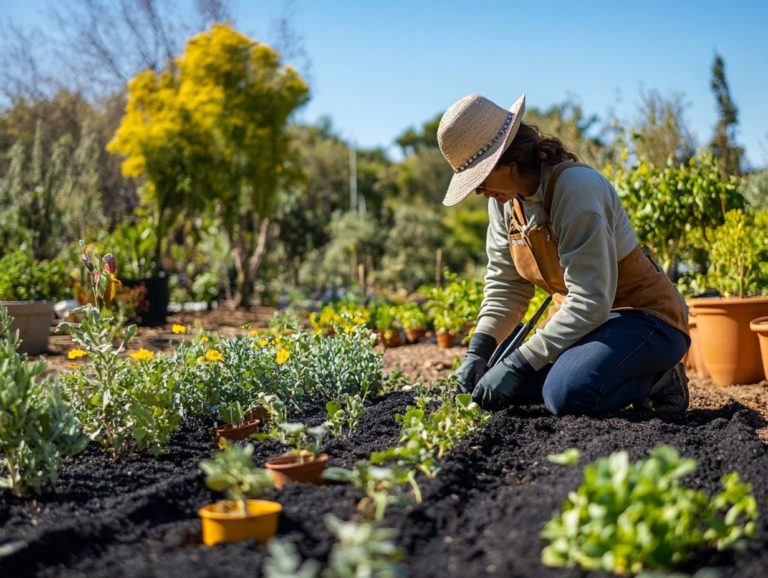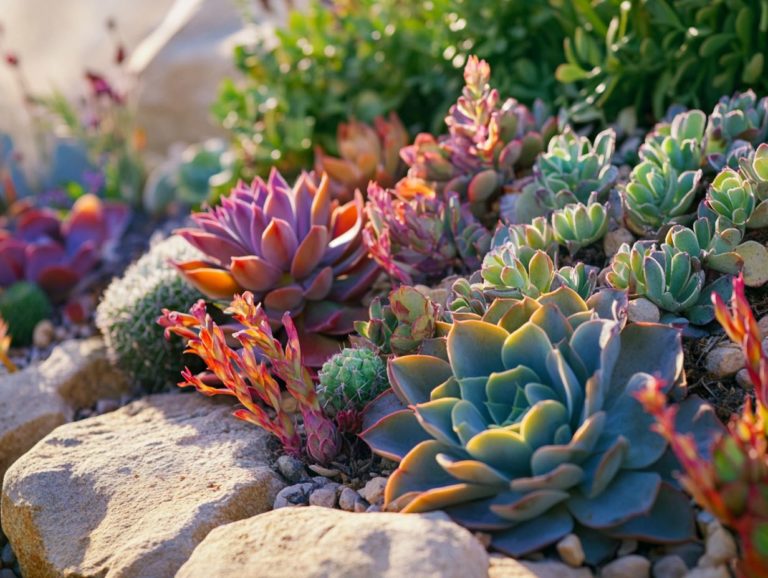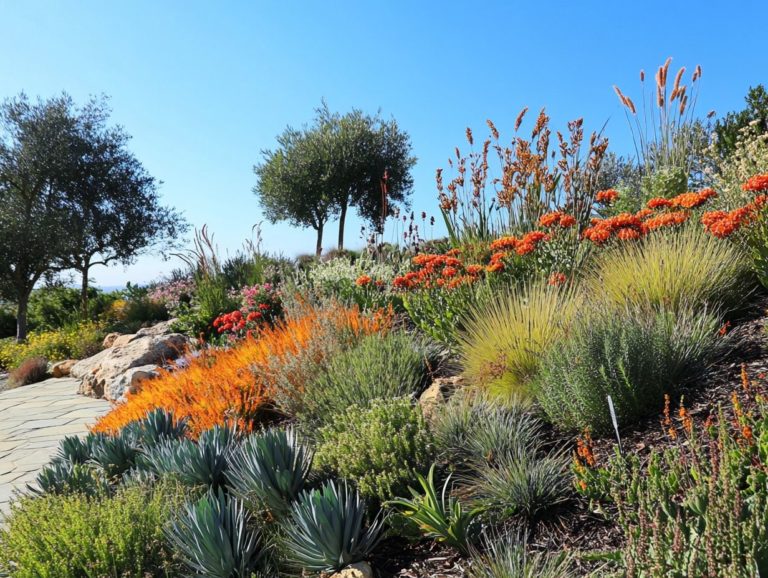What Are the Best Drought-Resistant Plants?
In an age marked by increasing climate variability, understanding the qualities that make a plant drought-resistant is more essential than ever for you.
This article explores the numerous benefits of integrating drought-resistant plants into your landscape, highlighting everything from environmental gains to cost savings.
You ll discover a variety of these resilient plants, including succulents, cacti, and native species that will transform your outdoor space today!
You ll also find practical tips for garden design using these hardy plants, such as designing a garden that needs little water and essential maintenance practices to ensure they flourish.
Join us on an exciting journey to create a stunning and sustainable garden, elevating both its beauty and resilience.
Contents
- Key Takeaways:
- Benefits of Using Drought-Resistant Plants
- Types of Drought-Resistant Plants
- How to Incorporate Drought-Resistant Plants in Your Garden
- Maintaining Drought-Resistant Plants
- Frequently Asked Questions
- What Are the Best Drought-Resistant Plants?
- What are some examples of drought-resistant plants?
- Do drought-resistant plants require any special care?
- Can drought-resistant plants be grown in any climate?
- What are the benefits of growing drought-resistant plants?
- Are all drought-resistant plants aesthetically pleasing?
Key Takeaways:
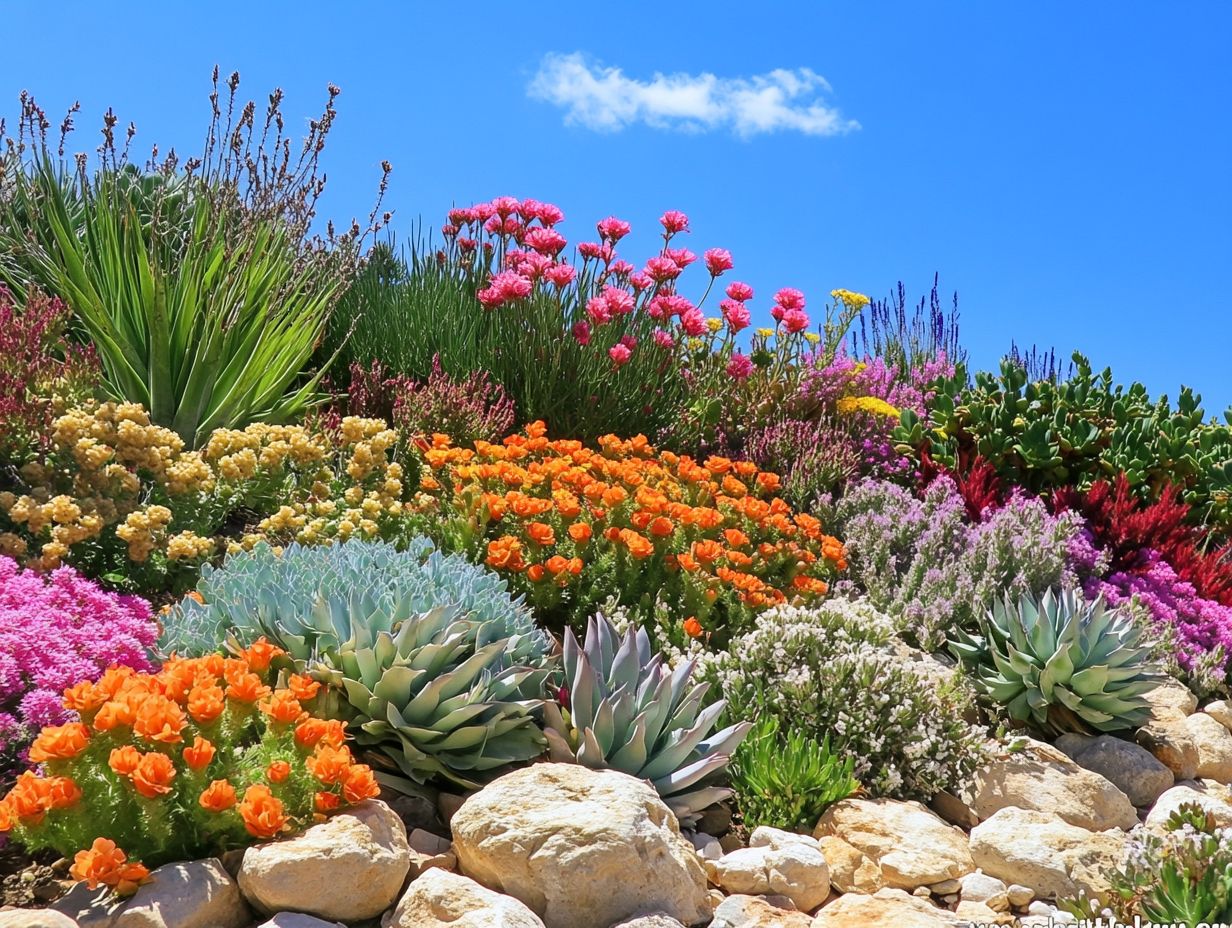
- Drought-resistant plants require less water, making them environmentally friendly and cost-effective.
- Succulents, cacti, native plants, and drought-tolerant varieties are all great options for your drought-resistant garden.
- Incorporating drought-resistant plants can add beauty and diversity, including low-water plants, and can be easily maintained with proper watering and care techniques.
What Makes a Plant Drought-Resistant?
Drought-resistant plants are your allies in the quest for thriving gardens in water-limited environments. To maximize their benefits, it’s important to follow best practices for drought-resistant gardening. These remarkable plants have evolved traits that not only help them conserve water but also enhance soil health and tackle the challenges of climate change head-on.
With deep root systems and waxy leaves, they minimize water loss while maximizing moisture uptake, making them essential for sustainable gardening and water-wise landscaping. Their ability to retain organic matter significantly boosts soil quality, creating a more resilient ecosystem.
Beyond their impressive root depth, which allows access to underground moisture, drought-resistant plants possess unique leaf structures designed to cut down on water release. Some even have small or folded leaves that minimize surface area, effectively reducing evaporation. This adaptability is vital, especially as climate change continues to challenge our water resources.
By embracing drought-resistant varieties in your gardening practices, you not only support water conservation efforts but also promote soil health. Healthy soil, rich with organic matter from decomposing plant material, nurtures a vibrant habitat for beneficial microbes and insects, fostering biodiversity.
Ultimately, choosing these plants beautifies your landscape and aligns your gardening endeavors with sustainable principles.
Benefits of Using Drought-Resistant Plants
Incorporating drought-resistant plants into your landscape design offers a wealth of advantages, from improving water conservation to fostering sustainable gardens that nurture local wildlife habitats. These gardens can include pollinator-friendly plants that attract essential species.
By integrating these plants, such as lavender and Russian sage, you not only minimize the need for frequent watering but also play a vital role in erosion control and the overall well-being of the ecosystem.
Moreover, drought-resistant plants, particularly native varieties, are often more resilient against the challenges posed by climate change, making them an excellent choice for the conscientious gardener. Learn more about why choose drought-resistant plants.
Start your journey to a drought-resistant garden today! Share your experiences and tips with others as we create more sustainable spaces together.
Environmental and Cost Savings
The environmental benefits of using drought-resistant plants go far beyond simple water conservation. They can lead to substantial cost savings for you and your community. By selecting plants that need less water, you can significantly reduce your water usage. Not only does this conserve a precious resource, but it also eases the financial strain of those hefty water bills.
Sustainable gardens with drought-resistant plants contribute to healthier ecosystems by reducing runoff and improving soil composition. Utilizing these resilient plants alleviates pressure on local water supplies and supports a balanced environment.
Less water runoff means decreased erosion and loss of nutrients, which ultimately enhances soil health. Healthier soil nurtures a thriving habitat for beneficial microorganisms, strengthening the ecosystem further. Start your sustainability journey today! This cycle not only reduces costs but also fosters biodiversity, transforming your garden into a vibrant extension of nature.
With thoughtful planting choices, you can cultivate landscapes that are not only beautiful but also play a vital role in preserving the integrity of the environment.
Types of Drought-Resistant Plants
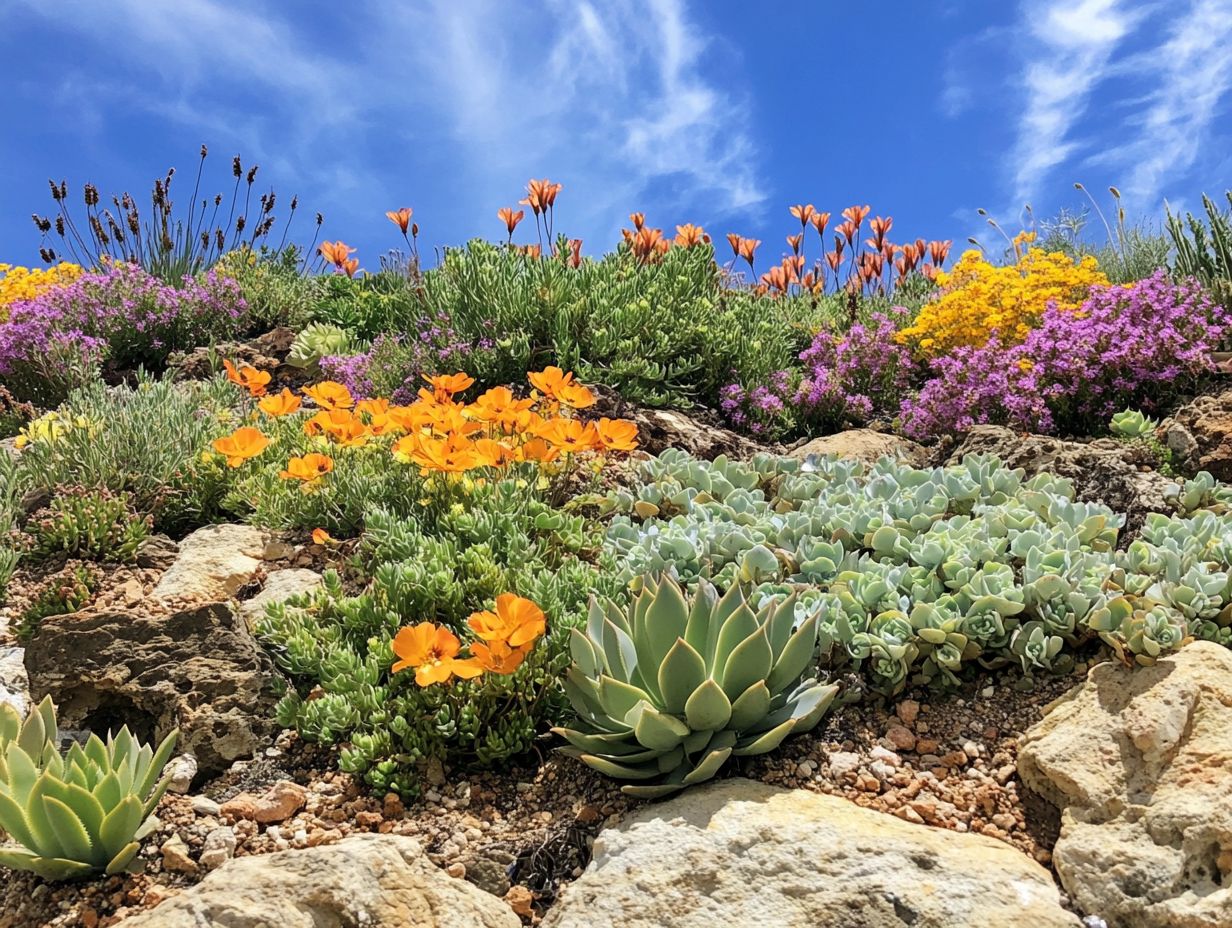
The world of drought-resistant plants is impressively diverse, including the best ground covers for drought areas, each bringing distinct advantages for gardeners like you in search of low-water solutions.
From native plants perfectly attuned to your local climate to vibrant flowering perennials and ornamental grasses, these plants form the backbone of an effective drought-tolerant garden.
Explore the different types of drought-resistant plants and discover how they can enhance your garden! Understanding your options can elevate the aesthetic charm of your outdoor spaces while promoting environmental sustainability. For more information on when to add these plants to your garden, check out the best times to plant drought-resistant plants.
Succulents and Cacti
Succulents and cacti stand out as some of the most esteemed drought-tolerant plants, celebrated for their remarkable ability to store water in specialized tissues. This makes them exceptional low-water options for arid climates. To learn more about their unique characteristics, check out the key features of drought-resistant plants. You’ll find these intriguing plants in a stunning array of shapes, sizes, and colors, effortlessly elevating the aesthetic of any garden design.
With their minimal water requirements and robust nature, succulents and cacti, along with flowering perennials like black-eyed Susan, require little maintenance and play a crucial role in promoting water conservation in landscapes.
Their adaptability allows them to flourish in a variety of environments, from rocky terrains to sandy soils, making them a versatile choice for both your indoor and outdoor gardens.
Take the striking Agave, for instance; its sharp leaves and architectural form can serve as a captivating focal point in a modern garden. Meanwhile, the cheerful Echeveria varieties infuse vibrant colors into container arrangements.
By incorporating these plants into xeriscape gardens (landscapes designed to reduce or eliminate the need for irrigation), you enhance visual appeal while significantly reducing the need for irrigation, paving the way for long-term sustainability. Their resilience against pests and diseases means you ll rely less on chemical treatments, ultimately contributing to a healthier ecosystem.
Explore your options today and transform your outdoor spaces into vibrant, sustainable havens!
Native Plants
Transform your garden into a vibrant haven with native plants. These plants are truly a treasure in drought-tolerant landscaping, providing a wealth of ecological benefits while demanding minimal care and water.
Since these plants are naturally adapted to their local environment, they flourish in native soil, enhancing soil health and promoting biodiversity.
By incorporating native plants such as lantana and butterfly weed into your garden, you can cultivate vibrant habitats that attract a variety of pollinator-friendly species. This all contributes to the overall vitality of your garden ecosystem.
Take, for example, the California poppy. This beauty thrives on limited watering and develops deep root systems that improve soil structure and promote nutrient flow in the soil.
The desert marigold also showcases resilience, fostering healthier soil conditions and allowing for better water retention for your plants.
Plants like butterfly weed and sacaton grass are essential for supporting local wildlife, including bees and butterflies, offering them nourishment and shelter.
Embracing native flora conserves water and simplifies maintenance while nurturing a flourishing ecosystem that reflects the beauty and resilience of your local landscape.
Drought-Tolerant Varieties
Drought-tolerant varieties offer a diverse collection of species, ranging from flowering perennials to ornamental grasses. All these plants are crafted to thrive in low-water settings.
These plants not only deliver stunning visuals throughout the seasons but also play a crucial role in sustainable landscape design by minimizing the need for irrigation.
By choosing the right drought-tolerant varieties, such as blanket flower and salvia, you can cultivate breathtaking gardens that harmonize with nature’s rhythms while conserving precious water resources.
Among the impressive flowering perennials, varieties like ‘Black Eyed Susan’ and ‘Daylilies’ truly shine, blooming vibrantly even during dry spells.
Ornamental grasses, such as ‘Blue Fescue’ and ‘Miscanthus’, introduce texture and movement while demanding minimal care. They are perfect for the eco-conscious gardener.
These selections elevate the visual appeal of your garden and support local wildlife by providing essential habitats. When chosen with intention, these resilient plants create a sustainable garden ecosystem that beautifully merges aesthetics with environmental stewardship.
How to Incorporate Drought-Resistant Plants in Your Garden
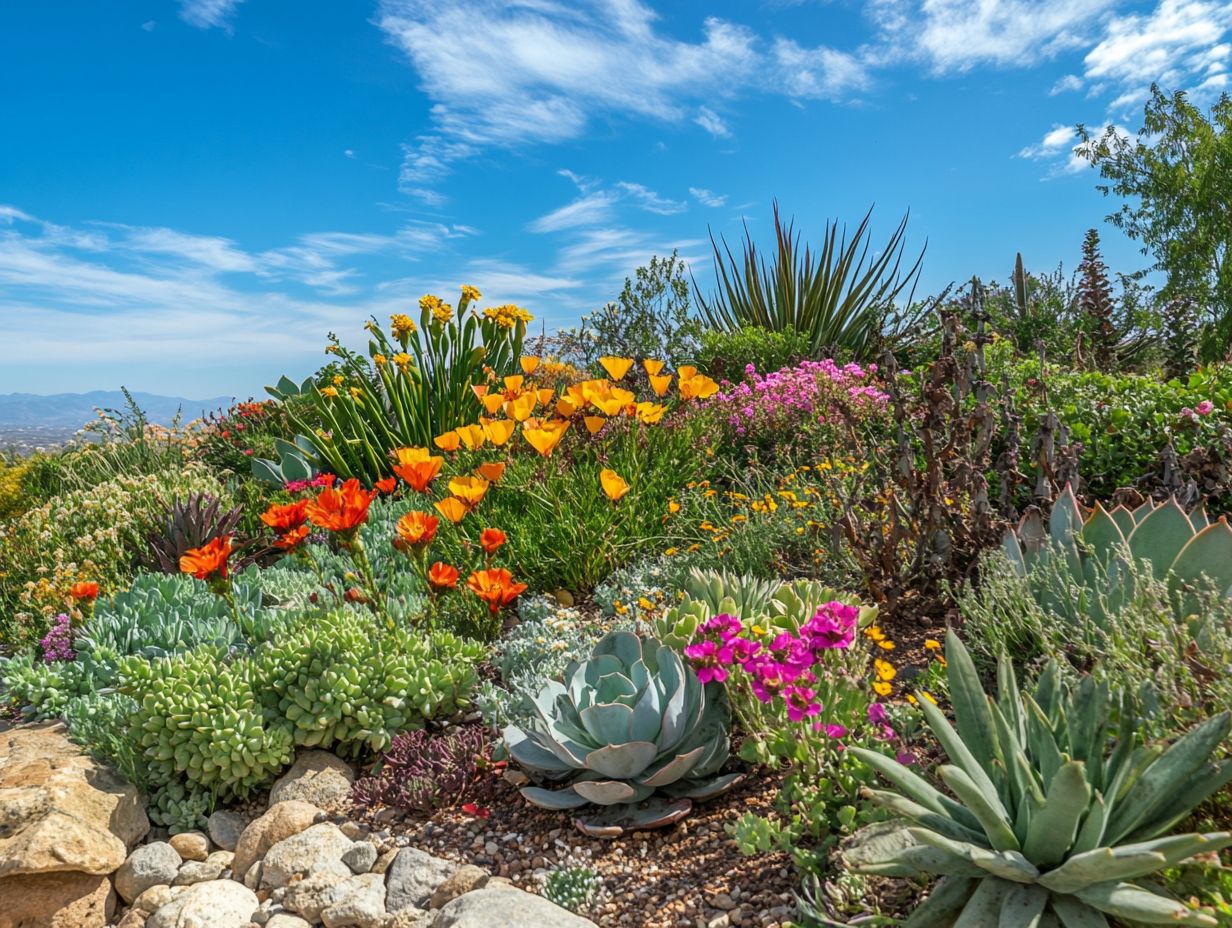
Incorporating drought-resistant plants into your garden can elevate it into a water-wise landscaping oasis, championing sustainability while maintaining exquisite beauty. For more information, check out the top drought-resistant vegetables.
By thoughtfully integrating these plants into your design, you can craft a visually stunning outdoor space that flourishes with minimal water.
Embracing techniques like xeriscaping a landscaping method that reduces or eliminates the need for irrigation and strategic plant placement will not only enhance the overall aesthetics but also fortify your landscape against the challenges of drought and climate change.
Design Tips and Techniques
Effective garden design is essential when you re incorporating drought-tolerant plants. It s not just about creating a stunning landscape; it s also about promoting water conservation and controlling erosion.
By employing design techniques such as grouping plants with similar water needs and maximizing mulch coverage, you can cultivate an efficient and sustainable garden that thrives even in low-water conditions.
A thoughtful design enhances the visual appeal of your outdoor space and significantly reduces your irrigation requirements.
To elevate your garden’s effectiveness, consider implementing strategies like incorporating native plants that are well-suited to your local climate. This approach boosts biodiversity and fosters a natural balance in your ecosystem while creating wildlife habitats.
Utilizing rock gardens and terracing can help maximize natural drainage. This prevents water runoff and allows moisture to penetrate the soil more effectively.
Smart plant placement like positioning larger drought-tolerant species on the sunniest side creates intentional shade for smaller plants, ensuring a harmonious growth environment and promoting erosion control.
These methods promote resilience and invite a flourishing landscape that transforms into a sustainable haven, integrating water-wise landscaping principles.
Maintaining Drought-Resistant Plants
Maintaining drought-resistant plants calls for a personalized strategy that focuses on little watering and optimal care techniques to ensure their health and longevity.
Even though these plants thrive with limited water, they still benefit from thoughtful watering practices and soil health management, which means keeping the soil rich in nutrients, that bolster their resilience and growth. Incorporating organic matter into the soil can further enhance soil health.
Understanding what your drought-resistant plants need can make a big difference. By knowing the specific needs of plants like flowering perennials and ornamental grasses, you can quickly create an environment that enables them to thrive. For more insights, check out emerging trends in drought-resistant plants, even in the most challenging conditions.
Watering and Care Techniques
Employing effective watering and care techniques is essential for ensuring the health of drought-resistant plants while promoting water conservation and enhancing soil health. These plants need less water than regular ones. A deep watering routine helps roots grow strong for thriving in arid conditions.
By combining mindful watering practices with regular soil health assessments, you can cultivate a thriving ecosystem that supports both plant and soil vitality.
Incorporating mulching techniques further aids in moisture retention. It minimizes evaporation and promotes the slow release of nutrients. Utilizing organic materials like wood chips or straw not only protects the soil but also enriches it as they decompose.
Regular soil amendments such as compost and well-rotted manure can significantly improve soil structure and fertility. They provide essential nutrients that support drought-resistant plants.
By carefully monitoring soil moisture levels and adjusting your watering schedule accordingly, you enhance the chances of flourishing plant life, ultimately leading to a more sustainable garden ecosystem.
Frequently Asked Questions
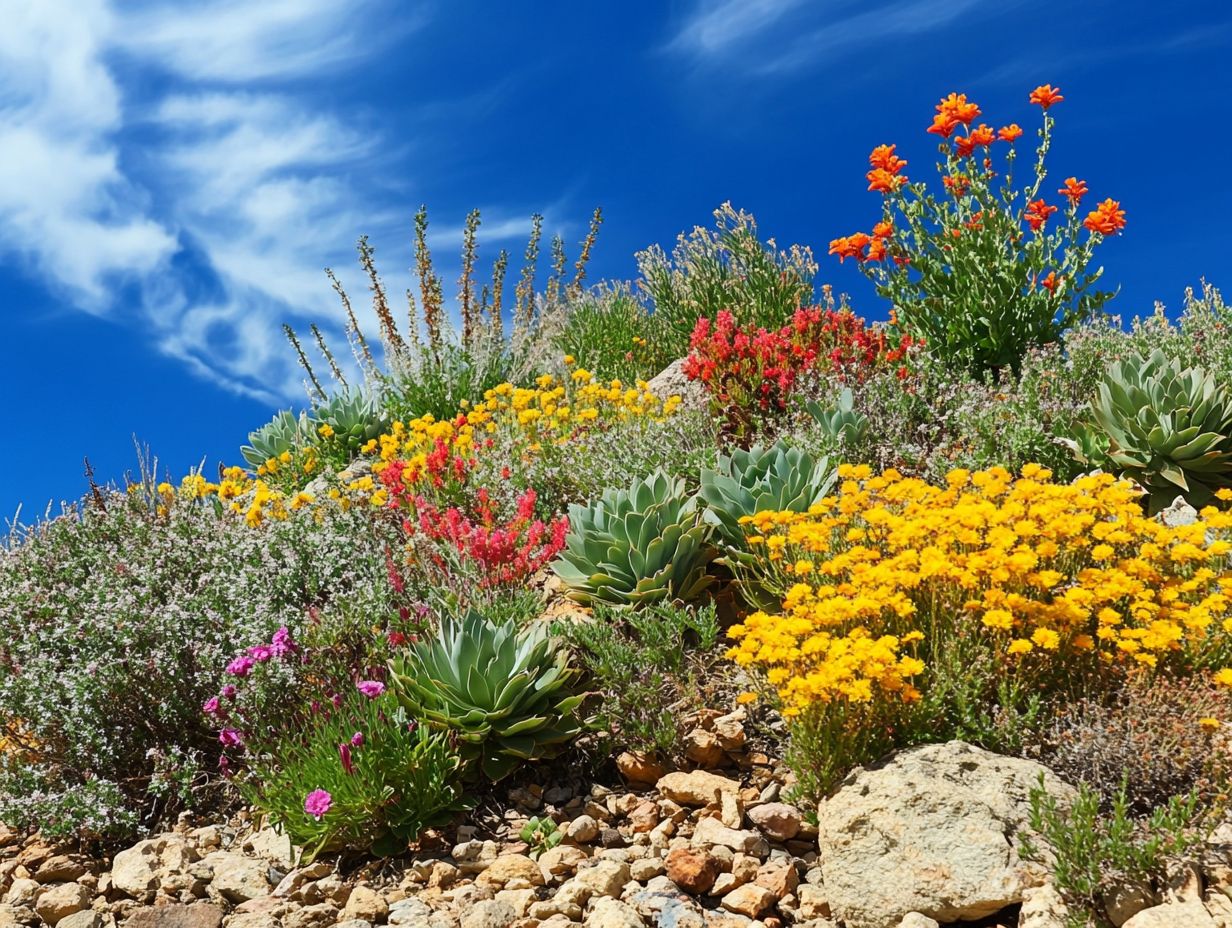
What Are the Best Drought-Resistant Plants?
The best drought-resistant plants survive with little water and thrive in dry weather. For those interested in enhancing their gardens, knowing the most resilient drought-resistant plants is key, as these plants are typically native to arid regions or have adapted to dry conditions over time.
What are some examples of drought-resistant plants?
Some examples of drought-resistant plants include cacti, succulents, lavender, rosemary, yucca, and sedum, as well as asters and beardtongue. For more information on these hardy varieties, check out what are the most common drought-resistant shrubs. These plants have evolved to store water in their leaves, stems, or roots, allowing them to survive in dry conditions.
Do drought-resistant plants require any special care?
While drought-resistant plants are hardy and can survive in dry conditions, they still require some maintenance. It’s important to provide them with well-draining soil and to water them deeply but infrequently to encourage deep root growth.
Mulching can also help retain moisture in the soil.
Can drought-resistant plants be grown in any climate?
Drought-resistant plants are typically best suited for warm and dry climates, but some varieties can also thrive in cooler regions. To discover the most colorful drought-resistant plants, it’s important to research the specific needs of each plant before choosing to grow them in a particular climate.
What are the benefits of growing drought-resistant plants?
The benefits of growing drought-resistant plants include saving water, reducing water bills, and having a low-maintenance garden. These plants add texture and interest to landscapes and can attract pollinators such as bees and butterflies.
Are all drought-resistant plants aesthetically pleasing?
No, not all drought-resistant plants are aesthetically pleasing. Some may have spiky or dull-looking foliage, while others bloom with vibrant and colorful flowers. However, there are many options for beautiful and visually appealing drought-resistant plants that can enhance the look of any garden.

